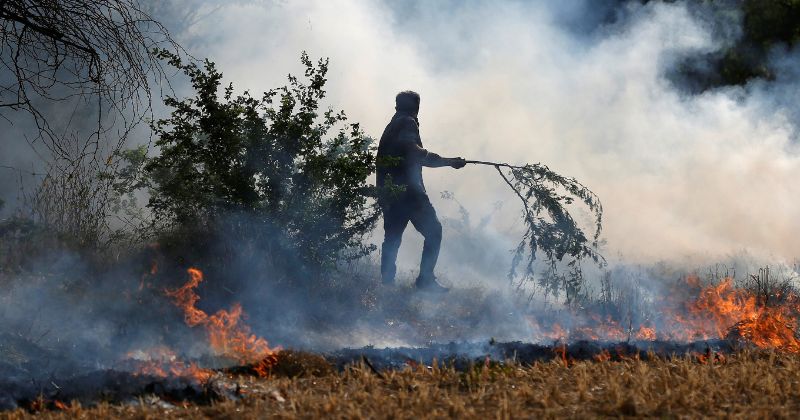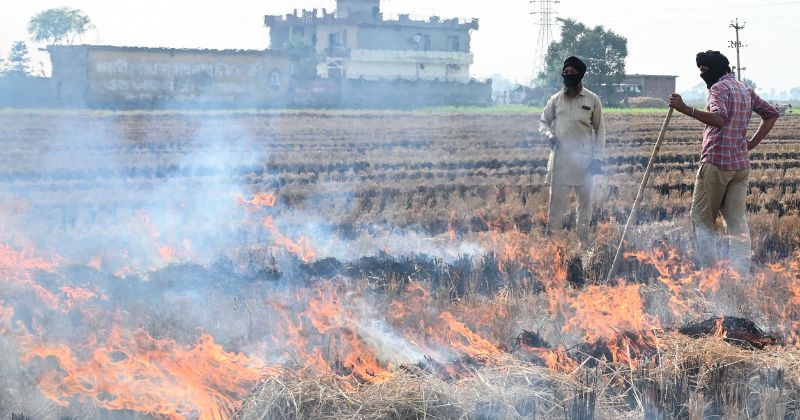
Air pollution in India and Pakistan has reached critical levels, prompting urgent action from authorities. On Tuesday, both nations took strict measures by arresting farmers for illegal stubble burning, a major contributor to the region’s worsening air quality during the winter months. The arrests underscore the severity of the pollution crisis, which has once again become a matter of public health and cross-border concern.
In India’s northern state of Haryana, at least 16 farmers were arrested for burning paddy stubble, a practice that has long been identified as a significant contributor to Delhi’s seasonal smog. Each year, the capital city of India struggles with a sharp drop in air quality due to smoke from neighboring states like Punjab and Haryana, where farmers clear their fields by burning crop residue. This year, the air quality in Delhi plummeted to an Air Quality Index (AQI) of 320 on Tuesday, which falls into the “very poor” category. An AQI over 300 is hazardous, particularly for children, the elderly, and those with respiratory conditions.
The Haryana police in Kaithal district confirmed that 22 complaints of stubble burning had been lodged this year, leading to the arrests of 16 farmers, all of whom were later released on bail. Local authorities are also investigating nearly 100 more farmers suspected of burning crop residue, and fines have been imposed on over 300 individuals. Despite years of efforts to curb the practice through awareness campaigns and penalties, stubble burning remains a persistent issue. The pressure on farmers to quickly prepare fields for the next planting cycle, coupled with a lack of affordable alternatives, continues to drive the practice.
Across the border, Pakistan faces a similar crisis. Lahore, the capital of Pakistan’s Punjab province, was ranked the most polluted city in the world on Tuesday, surpassing even Delhi. The smog in Lahore is driven by the same factors affecting India—stubble burning, industrial emissions, and vehicle exhaust. The situation in Lahore has prompted authorities to take action, with Punjab police registering 182 complaints against individuals involved in illegal activities contributing to pollution. These violations include not only crop burning but also the operation of smoke-emitting vehicles and unlicensed brick kilns. So far, 71 people have been arrested for contributing to the smog.
In a bid to find immediate solutions, the Pakistani government has also considered inducing artificial rain to clear the air, though this approach is expensive, with each attempt costing between 5 and 7 million rupees ($18,000 to $25,000). While these measures may provide temporary relief, they are unlikely to solve the underlying issues that lead to pollution each winter. In response to the escalating crisis, Lahore’s Chief Minister has called for “climate diplomacy” with India, urging both countries to work together to combat the cross-border pollution problem.
Meanwhile, in Delhi, the Indian government has introduced several emergency measures to address the worsening air quality. These include water sprinkling on roads to reduce dust, increasing public transportation to discourage private car use, and raising parking fees to limit vehicle emissions. However, environmentalists argue that these efforts are insufficient and merely short-term fixes. Vimlendu Jha, a prominent environmentalist, criticized the reactive approach, stating, “These are just emergency measures. We need a long-term, comprehensive strategy to combat air pollution, not these ad hoc solutions when things get out of control.”
Both India and Pakistan face similar challenges as they grapple with pollution levels that have far-reaching consequences on public health. While arrests and fines may deter illegal practices in the short term, the larger issue of managing air quality requires a coordinated, long-term approach. Cross-border cooperation, improved infrastructure, and affordable alternatives for farmers are critical to preventing the recurring winter smog crisis.
As air quality in the region remains hazardous, millions of people continue to suffer the consequences, and without sustainable solutions, the cycle of pollution and health risks will persist year after year. Both countries must look beyond temporary measures and invest in long-term strategies to ensure cleaner, healthier air for their populations.









